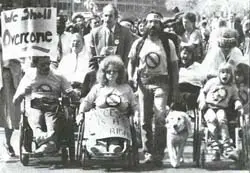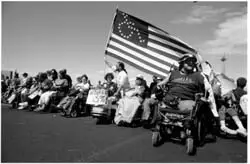Disability Rights
The fight for the rights for people that experienced disabilities began around 1962. This movement was a protest to make sure that people with disabilities had the same equal opportunities, safety and physical access to architecture, transportation, education, housing, employment and independent living that people without disabilities had. They wanted freedom from neglect, abuse, and fought against the violation of patients’ rights.


Prior to passing laws, anyone that had a physical disability that was in a wheelchair could not do something as simple as crossing the street without major problems hitting the curb. There wasn’t a way to take a bus, get into an office building or any public building without major problems. Those with physical as well as mental disabilities were discriminated against for jobs, even if they were the most qualified. Society considered people with disabilities to be ‘second class’ citizens.

Using the Civil Rights movement as a guideline, Ed Roberts began the Disability Rights movement in 1962 when he was lifted from a wheelchair and carried up the stairs of the University of California at Berkeley. The members of the movement were forced to sue the government to prove that they had the rights and the abilities to receive education, be employed and have access to public and private buildings.

It is important to understand that also during this time, Black Americans as well as women were being discriminated against. The topics were in the news but not many people had thought about those with disabilities having difficulties. Roberts began a movement at UC Berkeley that included the Physically Disabled Students’ Program that offered 24 hour help to any student that needed assistance attending school or even getting around.
By 1972 Roberts took his programs out of the school environment and into the general lives of those that were disabled with the founding of the Center for Independent Living. This was a non-profit organization designed to assist University graduates with a disability in the San Francisco Bay area to find jobs, living areas and other needs. This program, like the Berkeley program, was run and operated by people with disabilities and was so successful that today, there are over 300 centers around the United States.


Roberts and his group were joined by others with disabilities as they continued to protest and fight to achieve the same status and have the same chances that those without disabilities had. It took until 1992 when the Americans With Disabilities Act was finally passed. This new law made it a crime to discriminate against anyone with a disability as well as a requirement for all public and private buildings to accommodate the needs of those with disabilities.
Some of the examples of change that came about included: sidewalks and door entries had to have ramps for wheelchair access, buses would now have ‘lifts’ to accommodate a wheelchair, visually impaired people now had verbal and brail access for street crossing areas and elevators, revolving doors and stair areas now had to have separate areas for wheelchairs, schools had to make accommodations for those children that experienced physical and mental challenges due to disabilities.

Before the law, studies had shown that almost two thirds of those with disabilities were unemployed and a majority of the children with disabilities did not receive an education. The success of the movement protected those that experience both physical and mental disabilities and brought this group together to fight for their own rights.

The Disability Rights movement in the United States acted as an example for other countries to add accessibility and respect to their own citizens and make the kind of changes that are needed to allow those with disabilities to lead productive lives.




